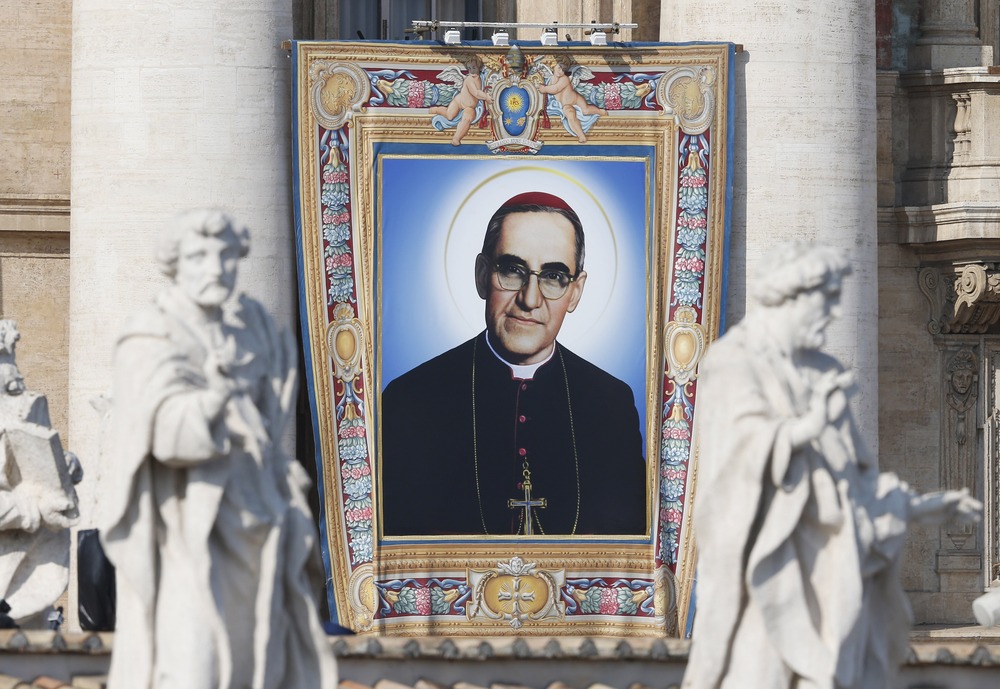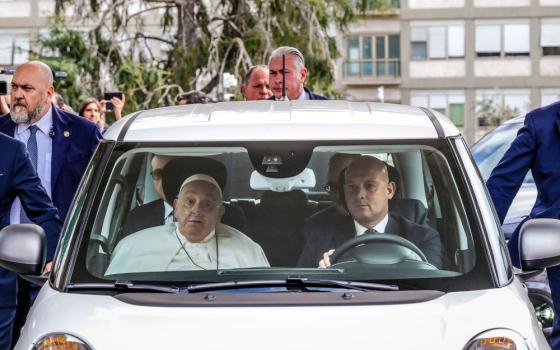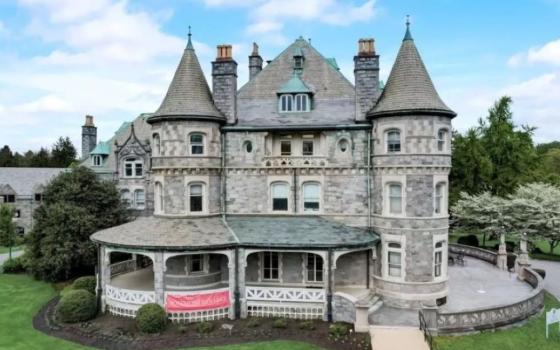
A banner of new St. Oscar Romero hangs from the facade of St. Peter's Basilica as Pope Francis celebrates the canonization Mass for seven new saints in St. Peter's Square at the Vatican Oct. 14, 2018. (CNS/Paul Haring)
A recent decision by officials in El Salvador to remove a painting of St. Óscar Romero from a prominent location in the nation's main airport and move it to a more secluded area, generated backlash from Catholics and opinion leaders, who have been critical of how the nation's government is treating national symbols while trying to rebrand the country as a safe and tourist-friendly destination.
The 18-foot-wide painting depicts different scenes of Romero's life, including a meeting that Romero had with people whose relatives had been abducted by the military.
The painting was commissioned in 2010 to mark the 30th anniversary of Romero's murder and it had been placed in a hallway of San Salvador's airport's departure hall, where it could be easily seen by passengers as they headed to their gates.
It was passengers at the airport who noted that the painting was no longer at its original location and had been replaced with a large poster that welcomes tourists to El Salvador, "the land of surfing, volcanoes and coffee." First reports on the disappearance of the mural were published May 20.
Officials initially provided no explanation for the painting's removal, sparking criticism from some Catholic leaders.
"The destruction of the mural alluding to Monsignor Romero at the Salvadoran airport is an act of damnatio memoriae (damage to memory) applied, in the mind of the ruling party, to its previous political adversaries," Fr. Juan Vicente Chopín Portillo, wrote in an opinion column, where he also criticized local bishops for not speaking out about what later appeared to be the painting’s removal, not damage.
He called on priests around the country "to mention Monsignor Romero in their homilies, so that his legacy does not depend on a wall, but on the virtues and convictions of Christians," Chopín wrote.
Advertisement
After being silent on the matter for several days, El Salvador's government announced on May 27 that the artwork had been moved to a small art gallery inside the airport that contains other pieces by local artists. Government supporters said on X that the painting is now better lit.
"We are a sovereign nation," President Nayib Bukele wrote on his X (formerly Twitter) account, "and we will display our artwork wherever we see fit."
Salvadoran president was referring to a post on X of U.S. Rep. Jim McGovern, who said May 26 that he was "deeply disturbed" to see the mural removed from its initial place.
"When I travel to El Salvador, I always pause upon my arrival at the painting to reflect on all that Saint Romero means to me and millions of others," he wrote.
Critics of Bukele noted that the painting was moved without respect for local laws.
A 2012 decree issued by El Salvador's Ministry of Culture afforded the painting a special status as a property of national cultural interest, and said its location could not be changed without a technical review process.
Carlos Colorado, a Salvadoran-American lawyer, who runs a blog about Romero, said that he was concerned that El Salvador's current government was being dismissive of the bishop's contribution to the nation's history.
Romero was the archbishop of San Salvador in the late 1970s, a turbulent period that led to a full-fledged civil war, in which more than 75,000 people were killed.
As a bishop, Romero spoke out against political violence, defended victims of the military and urged soldiers not to act against their own brethren in poor rural communities.
Romero was shot and killed March 24, 1980, as he celebrated Mass in a hospital in San Salvador. His beatification Mass May 23, 2015 was one of the largest public events in El Salvador’s history, with an estimated crowd of 250,000 people. He was canonized by Pope Francis Oct. 14, 2018.
The El Salvador airport was named after the legendary archbishop in 2014, and is named in Spanish Aeropuerto Internacional San Óscar Arnulfo Romero y Galdámez.
Bukele's administration seems to be trying to "gloss over" this period of El Salvador's history, Colorado told OSV News.
Recently, El Salvador's government tore down a monument to the 1992 peace deal that ended El Salvador's civil war — in order to make way for a park.
"Bukele is trying to change the image of the country, and that is probably a good thing to the extent that people think of El Salvador as a place with gangs, a place that is just recovering from conflict," Colorado told OSV News. "But he seems to be taking a heavy-handed approach."
The painting of Romero was unveiled in 2010 during an event in which El Salvador's government apologized for the bishop's murder in 1980, at the hands of a right-wing death squad.
As El Salvador undertakes a crackdown on gangs — a move that has made the nation safer, but has also resulted in the imprisonment of thousands of innocent people — some Salvadorans are concerned that the nation's current government is not giving due attention to human rights issues.






